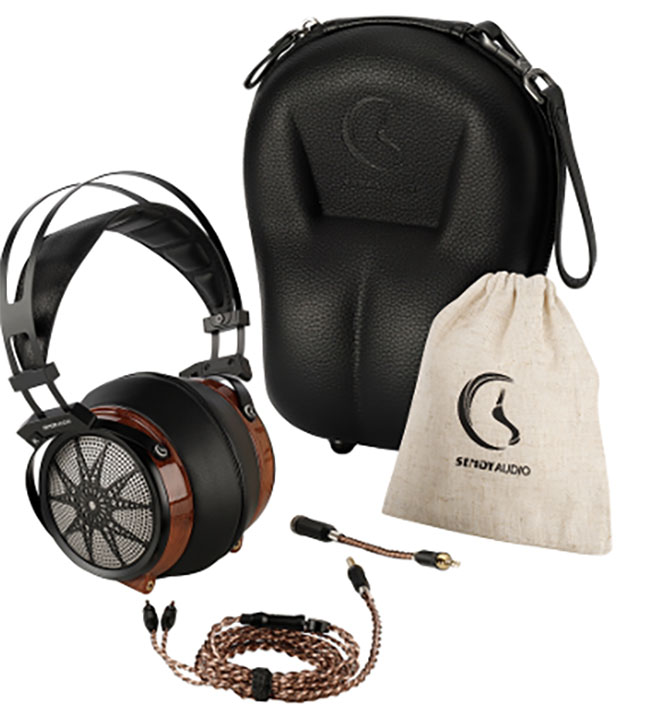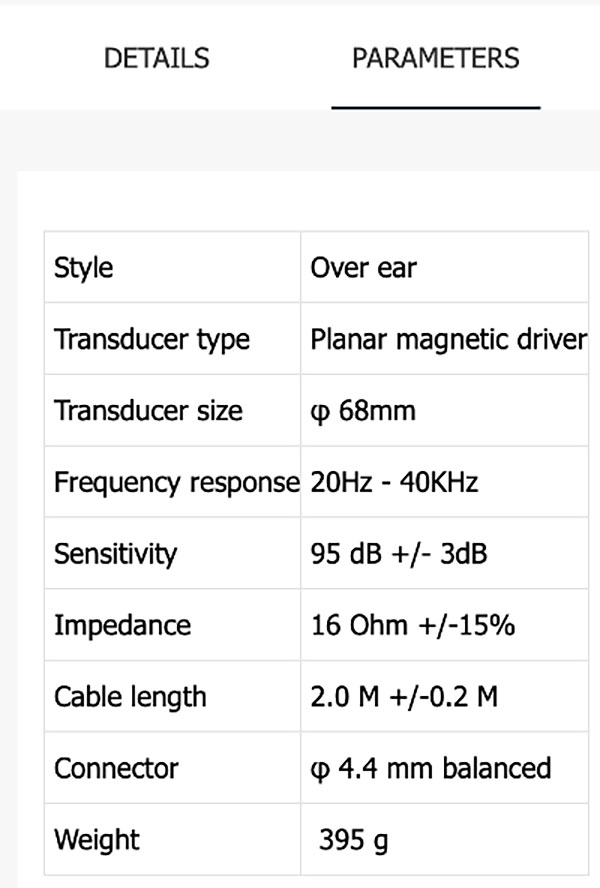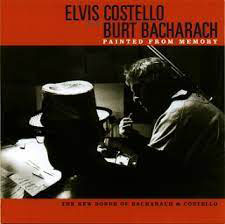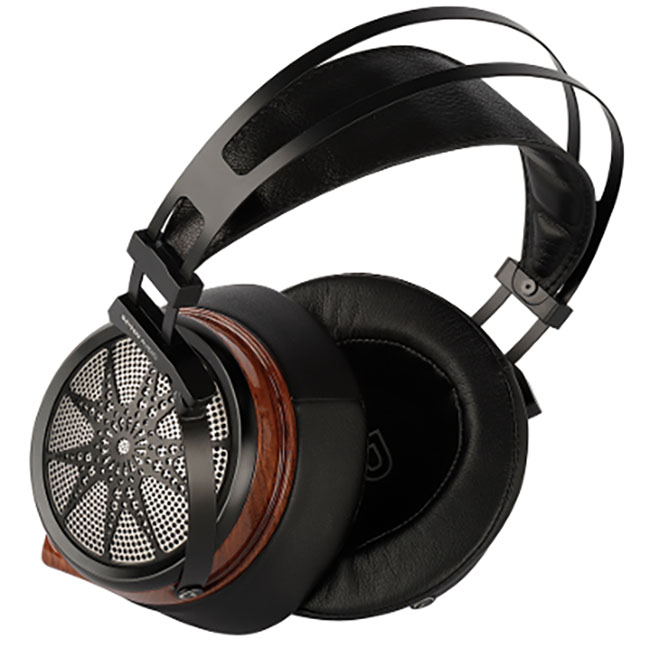Sendy Audio Apollo Planar Magnetic Headphone by Greg Voth

 I jumped at the opportunity to audition the Sendy Audio Apollo Planar Magnetic Open Backed Balanced Over-Ear Wood headphone – one model in a new line of headphones being offered by Walter Liederman’s www.UnderwoodHiFi.com. Let’s get the selling price out of the way – the Apollo sells for $499.99, which made this model a must hear. Reviewing other components while a neighbor renovates a bathroom would prove maddening. Reviewing a headphone during such an intrusion was a pleasure!
I jumped at the opportunity to audition the Sendy Audio Apollo Planar Magnetic Open Backed Balanced Over-Ear Wood headphone – one model in a new line of headphones being offered by Walter Liederman’s www.UnderwoodHiFi.com. Let’s get the selling price out of the way – the Apollo sells for $499.99, which made this model a must hear. Reviewing other components while a neighbor renovates a bathroom would prove maddening. Reviewing a headphone during such an intrusion was a pleasure!
The Sendy Audio Apollo is gorgeous. Its CNC sculpted, gloss-coated solid rosewood side components, lamb skin covered, soft and supple ear cups and headband, and decor, with steel mesh and sunlight design reflecting the model’s name. The Apollo is exceptionally comfortable to wear for extended listening sessions. Its ear cups are bowl-like. And can fit over the whole ear with no pressure on the ear. I’ve had them on for hours each day while auditioning and only wanted more. Besides Apollo’s affordability, what stands out is that the Apollo design includes a balanced listening option. For this review, I listened unbalanced.
Unboxing the Apollo was special. The kraft brown 2-part box was adorned with a delicate rendering of the Apollo on its top, accompanied by a few small splashes of branding and little else. Lifting the top half of the box revealed a form-fitted leather travel and storage bag. Nicely textured, this tough leather case firmly held the Apollo, along with a hemp bag containing a braided balanced headphone cable and a balanced 4.4mm to 3.5mm adapter for unbalanced use. The Apollo cable connects to the headphone at an angle toward the headphone’s front by way of a pair of 3.5mm jacks rather than connecting straight up from the bottom of each ear cup, allowing the cable to drape more ergonomically while worn.
 Sendy Audio, a sub-brand of Sivga Electronic Technology Co., Ltd., is a company committed to producing refined products for the audio market. Sendy Audio spent 3.5 years of dedicated research and development, tuning, and innovation to deliver its breakthrough line. The Apollo Planar Magnetic Open Backed Balanced headphone plays a foundational part.
Sendy Audio, a sub-brand of Sivga Electronic Technology Co., Ltd., is a company committed to producing refined products for the audio market. Sendy Audio spent 3.5 years of dedicated research and development, tuning, and innovation to deliver its breakthrough line. The Apollo Planar Magnetic Open Backed Balanced headphone plays a foundational part.
The Apollo spring steel over-head band, under which the lamb skin covered and cushioned headband hovers, is a nice change from my wounded Sennheiser HD-650s. I dropped the HD-650s, and the band cracked in two when I next spread the cups for a listen. I designed and printed a 3d bridge that holds the two halves together securely, but that injury to the HD-650s still smarts when recalled. The Apollo spring steel over-head band, a more durable design than the Sennheiser’s, piqued my curiosity.
Liederman made sure that his Logistics Manager, Charles Woods, applied at least 96 hours of break-in prior to shipping. As soon as they were received, I connected them to the LSA Discovery DPH-1 Preamp/DAC/Headphone and played them from the Music app on my iMac. Instantly comfortable, I gave the Apollo’s a few hours of early listening. The Apollo showed itself both engaging and soulful.
My go-to mini to 1/4″ gold-plated stereo adapter proved a weak link, no longer supplying a dependable stereo connection, and one of my two lengths of Grado Prestige headphone extension cables proved the same. I fired off a quick email to Mark Schifter, who works with Walter Liederman on the myriad of projects across his various brands. Schifter, who told me he’s been using the Apollo every day since Liederman adopted the Sendy Audio brand, replied, suggesting a Monoprice adapter as his preferred tool. I promptly ordered the Monoprice 3.5mm to 1/4″ stereo to stereo adapter.


Perusing The Apollo White Paper
Paraphrasing the Apollo white paper, Sendy Audio’s three years of dedicated R & D produced a planar magnetic driver with, in their words, “the best magnetic circuit and the best magnetic distance to balance the resonance.” Sendy’s planar magnetic driver is made of double magnets + double sides of coils on the diaphragm + double coils on each side of the diaphragm. This total of 4 coils on the diaphragm allows the diaphragm to provide the same vibration for each frequency and the double sides magnet provides consistent magnetic power in the field. [Any redundancy, theirs]. This construction results in excellent electroacoustic energy efficiency conversion, extremely low distortion, and consistency, with a high ability for music reproduction.
Paraphrasing again, the high internal damping base material used in the Apollo composite diaphragm delivers a natural and soft vocal and solid [not bloated] bass. The ultra-thin, highly rigid base material responsible for high-frequency reproduction extends frequency up to 40kHz, resulting in a bright treble with precise detail and a relaxing and comfortable listening experience. The Apollo sensitivity is 95dB (+/- 3 dB), its frequency range 20Hz – 40kHz, and its impedance 16 Ohm (+/- 15%).
The Apollo
Apollo’s name refers to “The Greek and Roman god of sunlight, prophecy, music, and poetry.” The Apollo’s fashionably drilled and sun-inspired outer cup steel decoration, its rays emanating
outward from the center to hold each side of the Apollo elements securely in place. The Apollo headband is made of padded goatskin, as are the ear pad covers. The ear pads are made of high protein materials and memory foam, which fit the entire ear, making them extremely comfortable for long listens. At 6’-4″ tall, my tall person’s ears were quite comfortable. The inside of each deep gloss-finished rosewood ear cup is labeled with a large L or R for easy identification. Outside, there are left and right indicators at the end of the headband. The included detachable 6n OCC braided cable, two meters in length (+/- 0.2M), ensures no signal loss during transmission. Both the Apollo cable and
detachable ear pads are easily replaceable.
The Apollo phones continued to improve sufficiently after their first 96 hours of introductory break-in. Each day brought new insights, with the Apollo aptly describing a compelling soundstage and dynamic range, providing low-frequency output that was not overtly bass-heavy or high frequency oriented. My 70-year-old ears appear to have a bit of a dip in the mids, which helps the bass and highs shine once that mid-sweet spot is reached. Once there, you’re rewarded with full bass (not overblown) and sweet, delicate highs that dance lightly with the music rather than etch their way into your consciousness. They did an admirable, even remarkable, job rendering dynamics during the hours of music I’ve played through them, and the planar magnetic tech inside brings fluidity and musicality to the ears without being “show-offs.”
Very recently, I developed a bit of Tinnitus in my left ear. Some daily sounds seem to aggravate the condition, like prolonged listening to highly dynamic, louder than necessary music. The Apollo appears to produce a more soothing aural picture that’s compelling without being stress-inducing. Even after hours of listening with the Apollo each day, that little high pitch I hear seems somewhat sedated. The Apollo is a headphone designed for long-time listening… and I did a lot of that.
Listening
 A spin of “Trio”, Julia Hülsmann, Marc Müllbauer, and Rainer Winch’s 2003 release (2000 BIT Musikverlag) drove home the virtues of the Apollo. “Blau Brün Brau,” a dynamic, spirited, joyful rump full of power and punch. Percussive banter was crisp and fun, the bass was full, and the closely miked piano held my attention. I wanted more at that track’s end. “Blick auk Meer” followed, ushering in a more contemplative atmosphere with good sound staging, depth, and transparency. “Strip It” brought the temperature up again, with increased energy, clarity, and inspired trio interplay – a nice pop to bass lines, drums that weren’t too forward, and keys that presented some nuanced phrasing, with humorous lines rhythmic comps. “Invitation,” a rather straight ahead take on the standard, still offered heat and nuance. A jazz take on “King of Pain” was unexpectedly blissful and poignant. There’s a lot to like in the Apollo presentation of this terrific jazz offering – this trio’s passion for playing was aptly delivered, with taut imaging, clarity, and air, drawing this listener in as almost part of the session itself.
A spin of “Trio”, Julia Hülsmann, Marc Müllbauer, and Rainer Winch’s 2003 release (2000 BIT Musikverlag) drove home the virtues of the Apollo. “Blau Brün Brau,” a dynamic, spirited, joyful rump full of power and punch. Percussive banter was crisp and fun, the bass was full, and the closely miked piano held my attention. I wanted more at that track’s end. “Blick auk Meer” followed, ushering in a more contemplative atmosphere with good sound staging, depth, and transparency. “Strip It” brought the temperature up again, with increased energy, clarity, and inspired trio interplay – a nice pop to bass lines, drums that weren’t too forward, and keys that presented some nuanced phrasing, with humorous lines rhythmic comps. “Invitation,” a rather straight ahead take on the standard, still offered heat and nuance. A jazz take on “King of Pain” was unexpectedly blissful and poignant. There’s a lot to like in the Apollo presentation of this terrific jazz offering – this trio’s passion for playing was aptly delivered, with taut imaging, clarity, and air, drawing this listener in as almost part of the session itself.
This morning I yearned to go on a sonic ride, selecting “Just Wrong,” my favorite track from Pino Palladino and Blake Mill’s 2021 release, Notes With Attachments (Impulse!), for play. There’s so much to love as this picturesque arrangement ebbs and flows. The track is melodically beautiful, with great depth and teaming with rich textures. The Apollo stepped up, relaying the depth and breadth of this recording, an album-length collaboration between bassist Palladino and guitarist, multi-instrumentalist producer Mills. Warm and rich, with a wide variety of sonic thrills, the Apollo presented “Just Wrong” just right, delivering impressive musicality with clarity and nuance.
Poinciana, the opening track on the Aaron Goldberg Trio’s 2018 “At the Edge of the World” (Sunnyside Communications), begins with great small details (hand on skin percussion and vocal punctuations that help present this well known Buddy Bernier and Nat Simon tune in an inventive and instantly engaging way). The Goldberg trio pays careful attention to the joy one gets from percussion with depth, character, and nuance. Need confirmation? Check out 2012’s Yes!, another Sunnyside release I play often.
 Reaching for a little something different, I came by Elvis Costello and Burt Bacharach’s 1998 “Painted From Memory” (Mercury Records), played here as a 24/96 home rip from MoFi vinyl. The Apollo rendered excellent depth of both space and resolution from the first track, as delicate strings and solid low frequencies wafted about marvelously. Elvis’s passionate vocals were reproduced with a well-defined body and delivered in a heartfelt performance. Next is Tears at the Birthday Party, an excellent pop piece in lyrics, backing vocals, and dramatic depth. The bass was full, mids warm, and full-bodied, with wide and deep orchestration and relaxed as it surrounded my head. There was a nice delineation within the large mass of instrumentation presented, even as both volume and density increased near the song’s end.
Reaching for a little something different, I came by Elvis Costello and Burt Bacharach’s 1998 “Painted From Memory” (Mercury Records), played here as a 24/96 home rip from MoFi vinyl. The Apollo rendered excellent depth of both space and resolution from the first track, as delicate strings and solid low frequencies wafted about marvelously. Elvis’s passionate vocals were reproduced with a well-defined body and delivered in a heartfelt performance. Next is Tears at the Birthday Party, an excellent pop piece in lyrics, backing vocals, and dramatic depth. The bass was full, mids warm, and full-bodied, with wide and deep orchestration and relaxed as it surrounded my head. There was a nice delineation within the large mass of instrumentation presented, even as both volume and density increased near the song’s end.
Comparisons
The Sendy Audio Apollo Planar Magnetic Open Backed Balanced over-ear headphone has an impedance of 16 Ohm +/- 15%, placing them in the low impedance camp (designated as below 50 Ohm), allowing them to work easily with portable devices, hence the use of a 3.5mm jack as standard. My iPhone 8 delivered instant musical satisfaction at ample volume when adapted using a mini-to-lighting dongle for play.
With the LSA Discovery DPH-1, the Apollo gave me plenty of substance and offered a cavity in both extremes, with sweet highs and abundant low frequencies. After ten days of listening with the Apollo, I switched to my Sennheiser HD-650s. I was surprised how much lighter they sounded – while their highs were light and airy, perhaps besting the Apollo a touch there, the rest of the picture was somewhat analytical, lacking both in body and low-frequency impact compared to the Apollo. The Apollo delivered far more depth and punch with warmth, as though dipped in honey.
Compared to my B&W P2 (v5) headphones, the Apollo handily bested that smaller, lighter fare, with far more body, more air, less bloat, and a much better balance of instrumentation and a greater sense of musicality. Both are lower impedance headphones, but the Apollo just delivered a more natural, effortless, and compelling presentation with a sense of heft and horsepower.
Through the PS Audio Gain Cell DAC’s headphone stage, the Apollo delivered a relaxed, enveloping picture at a volume designation of 25 on the unit’s front display (the iMac’s digital output maxes out when the digital out setting is selected). The Sennheiser’s needed a setting of 35 to reach the same relative impact. Not a huge difference in settings, but quite a difference in presentation. I much prefer the Apollo for its warmth, clarity, and reward.
The Wrap
The Sendy Audio Apollo is an immediately engaging headphone. Its lightweight design, comfort, and craftsmanship handily won me over. The Apollo’s large diameter diaphragm (68mm) and high-efficiency electroacoustic energy conversion delivered naturalness, musicality, and drive. Further, its soft, warm vocals, solid bass with depth, not bloat, and the clean, precise detail and transparency that I crave ultimately won me over. Highly Recommended


greg voth
Specifications:
Sendy Audio Apollo Planar Magnetic Open Backed Balanced headphones.
Pricing: $499.99
Included: the Apollo headphone, one hemp bag with one balanced headphone cable with one balanced 4.4mm to 3.5mm adapter, and one leather carrying bag.
Parameters:
Style Over-ear
Transducer type Planar magnetic driver
Transducer size © 68mm
Frequency response 20Hz – 40KHz
Sensitivity 95 dB + – 3dB
Impedance 16 Ohm +/-15%
Cable length 2.0 M +/-0.2 M
Connector 4.4 mm balanced
Weight 395 g
Contact:
Walter Liederman
Underwood HiFi
770-667-5633
Websitee: www.underwoodhifi.com
Stereo Times Masthead
Publisher/Founder
Clement Perry
Editor
Dave Thomas
Senior Editors
Frank Alles, Mike Girardi, Russell Lichter, Terry London, Moreno Mitchell, Paul Szabady, Bill Wells, Mike Wright, and Stephen Yan,
Current Contributors
David Abramson, Tim Barrall, Dave Allison, Ron Cook, Lewis Dardick, John Hoffman, Dan Secula, Don Shaulis, Greg Simmons, Eric Teh, Greg Voth, Richard Willie, Ed Van Winkle, Rob Dockery, Richard Doron, and Daveed Turek
Site Management Clement Perry
Ad Designer: Martin Perry









Be the first to comment on: Sendy Audio Apollo Planar Magnetic Headphone by Greg Voth